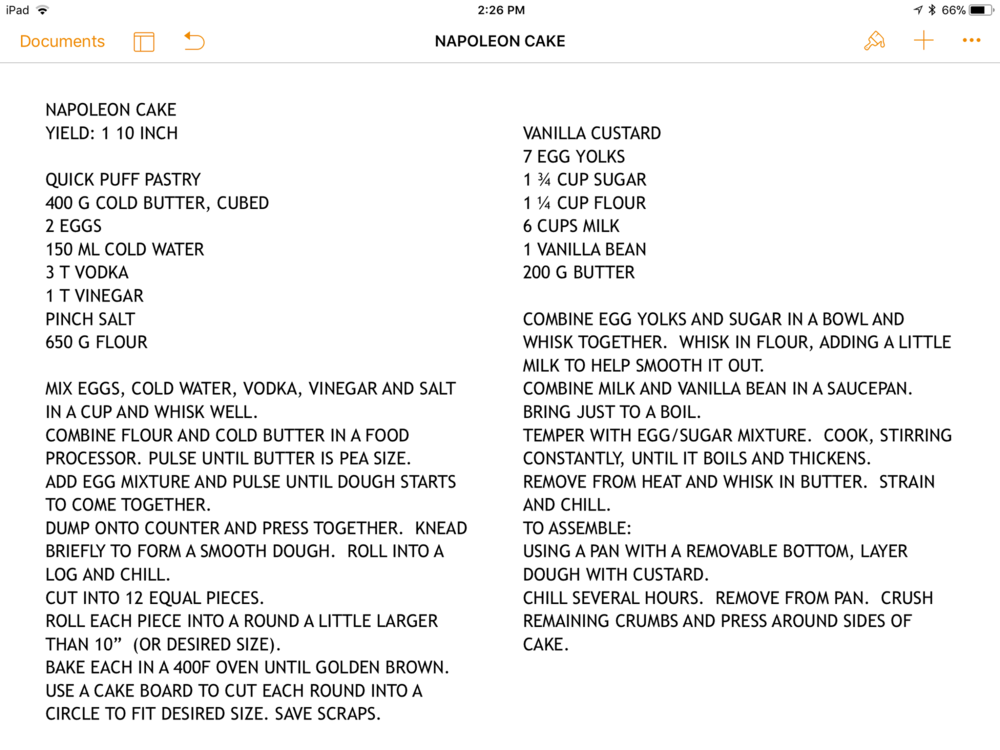-
Posts
883 -
Joined
Content Type
Profiles
Forums
Store
Help Articles
Everything posted by RWood
-
Chef Rubber has a line of fruit powders now. They have 4 oz jars. You might check on Craftsy, I think they are cheaper there than directly from CR.
-
I'm not a fan of white chocolate, only eat it if it's added to something. I use Opalys a lot at work, but there it's only for additions to buttercream, ice cream or a white chocolate layer cake. I would use it more outside of work if not for the price. I prefer it over the Ivoire. I personally do like to use El Rey's Icoa, I used it quite a bit in the past for my molded chocolates and fillings. Was always easy to work with. I order it directly from them in Texas. It's best to order in the colder months from them, they will only ship overnight or 1 day in the summer. So, there's the added shipping cost. I know the flavor either has you loving it or hating it.
-

Your Daily Sweets: What Are You Making and Baking? (2017 – )
RWood replied to a topic in Pastry & Baking
So, time for my birthday cake. I loved the Wonder Woman movie and decided to go with that this time. I didn't need a lot of cake, so the bottom and top tiers are dummies. Middle is marble cake. I never know what I'm gonna do untiI I start, and some ideas didn't make it, but I'm happy with it. I gotta learn to not wear myself out trying to get it all done after working all day. Took about three afternoons (after trying things that got scrapped.) -
You kinda have to think of cheesecake as a custard. It's set with eggs, so it needs to be baked low and slow. And not overbaked, which I think some people have issues with since it may not look set and keep baking it. For Christmas, I made a goat cheese cheesecake, and I baked it at 350 for 15 mins, turned it down to 275 and baked about 45 mins more (this was a small 7"). It still had a soft jiggle in the middle. I left it in the oven with the door ajar until it cooled. Then ran a knife around the edge. The texture was perfect.
-
I don't usually make cookies for Christmas anymore, but my mother begs for decorated cookies. Just vanilla cut out cookie with royal icing. I generally don't have the patience to color lots of icing and wait on stages of drying, so not my favorite thing to make. So, I bought these Prettier Plaques by Julia Usher. Love them! Still takes a little while, but all I had to do was one color of icing for a base, then put color in my airbrush.
-

Your Daily Sweets: What Are You Making and Baking? (2017 – )
RWood replied to a topic in Pastry & Baking
I would just cut a piece to fit the bottom of your pan. I never lined loaf pans at all, but a chef I worked with insisted on it (because his mama did it) and it did make a difference. -
Look up Coca-Cola Cake. Being from the south, that was always a cake I remember growing up.
-
They all look really nice, Jim. I'm glad it worked better for you. But, seeing all that that you've gotten done just reminds me that is till haven't made anything for holidays
-

Your Daily Sweets: What Are You Making and Baking? (2017 – )
RWood replied to a topic in Pastry & Baking
Round two on Thor's hammer. I was gonna try a different set up than last time, but a) this thing weighed a ton and b), I was worn out from working all day then making this at night. So, Ace got the same as a couple of years ago. He was happy though. -

Your Daily Sweets: What Are You Making and Baking? (2017 – )
RWood replied to a topic in Pastry & Baking
Well I made the snakes and clasp last weekend, and the eye a couple of days before. I did all the outside details yesterday after work. That's was probably 3-4 hours. The stitches took the longest, probably an hour for just those. -

Your Daily Sweets: What Are You Making and Baking? (2017 – )
RWood replied to a topic in Pastry & Baking
BoooooOOOOOOK! Finally got this out of my system. Didn't happen last year like I planned. Eye is made of isomalt, fondant for all the other details. Cake is red velvet with cream cheese Swiss meringue buttercream. -

Your Daily Sweets: What Are You Making and Baking? (2017 – )
RWood replied to a topic in Pastry & Baking
This seems to be the only style cake I ever make anymore . I really wish these brides had a sense of adventure. But, I have a couple of fun things coming up that will help get some variety. This was almond with raspberries and ganache. -
Doweling has nothing to do with the pastry cream. The dowels are for support when stacking multiple cake tiers on top of each other. You wanna take the chance of it collasping, that's fine. I just choose to not ruin someone's wedding with their cake in a pile on the floor.
-
You would definitely need support as with any tiered cake. So, dowels for sure. I think that something with gelatin would be your best option for stability with the filling, like a Bavarian maybe. But, with that being said, I’ve added a photo of a recipe that I’ve made before that just had a stiff pastry cream. Not sure if you want to go to the trouble of making the dough rounds, but there’s the option. It seemed pretty sturdy, and the layers of pastry cream aren’t very thick. This makes one 10” cake. As far as the look, I would stay with the naked cake idea. Floral decoration, fruit or whatever she likes with powdered sugar would look nice. I think frosting would be too much.
-

Your Daily Sweets: What Are You Making and Baking? (2017 – )
RWood replied to a topic in Pastry & Baking
I get griped at all the time about how much I despise raisins. I'm so glad I'm not alone -
- 14 replies
-
- 1
-

-

Your Daily Sweets: What Are You Making and Baking? (2017 – )
RWood replied to a topic in Pastry & Baking
Not the best photo, but I made Tiramisu for my cousins birthday dessert (don't think he's ever had it-but he really liked it). Family members beg for it, and I'm like "yeah, whatever". But I tend to forget how good it is -
Azelia is tasty by itself . I've only used it in ice cream and in buttercream. But, I've added additional chopped hazelnuts to both. I wouldn't mind trying to new fruit flavored, my passion fruit bon bon is one of the most popular, to my surprise.
-

Your Daily Sweets: What Are You Making and Baking? (2017 – )
RWood replied to a topic in Pastry & Baking
My step-sister's wedding cake. Her theme was Mediterreanean (she's Greek), so olive branches for most of the decorations. Took two years, but I'm glad its over and done. Cake is almond with ganache and raspberries. -
Haven't tried the Orelys yet, but I've been using the Opalys (33% white) a lot, and I have a bag of the Waina (35% white) that is different. Very vanilla-y. The one on the left is Opalys, and the right is Waina. Very different. I was looking on Valrhonas website, and they also have passion fruit and strawberry chocolate. Getting a little crazy.
-
I think that is the holy grail, not being able to tell something made with alternative flours is GF. Maybe I'm a picky pastry chef, but the few things I've had from this bakery always make me want to go and offer consultation. I think there must be a better way, but if these bakers and their clientele are happy ... One of my SILs is GF, I'll have to find some of that cake flour so I can make something she can eat for holiday desserts. I know what you mean. I think the blend is easier to find, maybe some supermarkets. I like it because it doesn't require the addition of xanthum gum. The cake flour does. You can order directly from them, but the shipping is outrageous. I think I found the cake flour from a site called Vita-cost. Much better shipping costs. Theres a cookbook called Patisserie Gluten Free that's really nice. Authentic Foods is the recommended flour in the book. Fortunately I don't get a lot of GF requests, but I feel OK with cakes I can offer now after trying so many other flours.
- 14 replies
-
- 1
-

-
Authentic Foods makes a GF cake flour and a regular baking blend that I have found work best. I've used them in a few wedding cakes and I've been really happy with how they turned out. I leave the cake trimmings out for they guys in the kitchen and everyone loved the chocolate cake and had no idea it was GF.
- 14 replies
-
It would need refrigeration, I wouldn't trust it. But, the recipe mentioned above for inside out German chocolate from Epicurious would work. It's made with dulce de leche, nuts and coconut, so no eggs to worry about.
-
Those all sound great. I'll check them out when I get around to chocolates again. I have my step sisters wedding coming up, and she wants chocolates, so would be nice to use the family oil in one. Thanks!
-
I tried an olive oil bon bon a while back, and wasn't pleased with it. I used white chocolate for the filling. I think I just tried a regular ganache with the addition of the oil at the end. Just seemed too greasy. I wanted to make one because every year we get a supply of oil from Greece from some property that belongs to my step dad and his brother. It's got great flavor and I thought it would be fun using that oil. Haven't tried again. I wonder if dark chocolate would be better? When I get a chance I might attempt again with some of the suggestions here.











